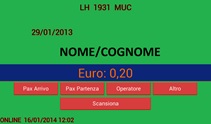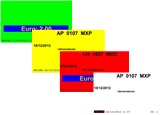BUSINESS
SHOP VIEW
OVERVIEW
ShopView provides automation to Retailer Management activities, through the acquisition of sales transaction data from cash registers or directly from retailer management systems and the analysis of sales data. The system allows you to match operational data of the airport directly with the transactions information obtained from the cashes through the ability to read and associate the purchase with the data on the buyer’s boarding card. In this way complex analysis can be done by bringing out the habits of purchase of airport passengers. Products purchased can be associated to boarding pass data as destinations and airlines.
The analisys on the collected data are extremely useful for:
- airport commercial departments can have data in real time to monitor the sales trend with respect to the expectations
- the component of strategic analysis and layout configuration of the commercial areas can define alternative and more profitable configurations based on sales profiles of the types of businesses for the various destinations and airlines
- the Avio Marketing department can better evaluate the profitability of new flights, being able to have passenger analysis functions as customers and statistical measurements of the economic performance per carriers, destinations and periods.
ShopView is a system that requires the presence of probes in each shop that are able to acquire, in a non-invasive mode, data on the receipt and to read the boarding passes in a simple and easy way. The design of the system was driven by the need to reduce as much as possible infrastructure and physical interconnection problems with cash registers through:
- the preparation of connection cables that do not alter the original layout by operating in a passive way
- the availability of extremely ergonomic devices for shops for which boarding passes reading is required
- the availability of web services for direct interconnection with back office management systems for the most advanced retailers.
In addition to the system’s target functions, ShopView provides a series of tools for proactive control of the cash devices to alert real-time technical assistance in case of lack of connection with the point of sale through the generation of alarms via email. All the events of up and down of the connections are also historicized for subsequent analysis as they are of vital importance to justify any inconsistencies between the revenues collected and revenues declared by the exhibitors. It is important to note that in case of data loss, the system is able to import incomplete periods by means of a structured Excel sheet provided by the operator himself.
BENEFITS
The ShopView solution by Software Design presents unique features that are the result of a perfect combination of the wealth of application functionalities of the system and the system integration experience that the company makes available to its customers:
- “non-intrusive solutions with legacy shop devices, so as to allow the installation of the system in any configuration of park retailers”
- “strong compatibility with existing airport infrastructures with particular reference to networking aspects”
- “loose coupling integration with flight data in the airport database”
- “high levels of customization that allow to guarantee coverage even to the most urgent needs”
Finally, the ShopView system, although aimed at monitoring purchase transactions, integrates natively with the passenger tracking systems made available to the AOSnice platform, enhancing the ability to control and monitor passenger flows.
SOLUTION COMPONENTS
CONNECTIONS TO THE BOXES
The Electronic Cash Register (ECR) are interfaced to the central system through two different modes:
- physical interface
- interface to services through the connection between the management system of the operator and the central system through Web services

Cases equipped with tablets can have barcode reading capabilities for both boarding passes and fidelity cards. The barcode reading can be done through two methods:
- reader integrated into the tablet
- camera of the tablet.
TABLET

BARCODE READER

SYSTEM ARCHITECTURE
The system consists of the following primary components:
- central system for processing and storing sales data
- configuration application in the back office environment
- peripheral devices interconnected to the cashier with their respective user application
The cashiers are interfaced to the central system through two different modes:
- physical interface:
- o direct connection between the cash desk and the central system through a peripheral serial / LAN conversion device
- o connection through a peripheral device of the tablet type (in case of need to read the barcode)
- interface to services through the connection between the management system of the operator and the central system through Web services
With regard to physical interfacing, two different types of cashiers configuration are possible:
- “Compound” box consisting of a PC connected to an external fiscal printer through RS232 serial lines
- “Integrated” cashier
The physical interfacing technique for the “composite” cashier type includes:
- a connection of the peripheral device to the central system through a network connection;
- a connection of the peripheral device to the fiscal printer, through a serial splitter.
The physical interfacing with integrated cashiers can be done in one of the following ways:
- Connection to an auxiliary cash register serial number that has the duplication of the printed receipt
- Connection to an auxiliary cash register serial that has a handshaking protocol whose characteristics are documented and available.
Cases equipped with tablets can have barcode reading capabilities for both boarding passes and fidelity cards. The reading of the barcode can be done through two methods: reader integrated into the tablet, camera of the tablet.
All data captured by peripheral devices connected to the cashiers are sent to the central system via wireless or wired networks:
- Ticket data: Date / Time, Shop Identifier, Good Category, Cost, Quantity
- Boarding Pass data: Flight, Acceptance Class, Boarding pass code, etc. cashier CASC
THE ITER OF DATA ACQUISITION
Transaction data is acquired through peripheral devices. Once the data have been acquired, parsers dedicated to each type of cashier of the various manufacturers allow to interpret the data according to the specific protocol.
All the data acquired, both through the receipt and the boarding passes, and independently from the source, are recorded in the central database in a highly structured manner.
The Configuration environment is responsible for the configuration of all the basic elements that contribute to the analysis of purchase transactions. In particular, this environment is aimed at managing the main entities in the system database:
- Retailers present at the airport
- Stores (Shop) for retailers
- Cash registers for point of sale
- Product categories
- Articles for retailers
ENVINOMENT CONFIGURATION
Transaction data is acquired through peripheral devices. Once the data have been acquired, parsers dedicated to each type of cashier of the various manufacturers allow to interpret the data according to the specific protocol.
The system also allows data acquisition through uploads from an appropriately formatted external file.
In addition, a web service is available that can be invoked directly by the merchant’s server systems, this option is typically adopted by large retail chains.
All the data acquired, both through the receipt and the boarding passes, and independently from the source, are recorded in the central database in a highly structured manner.
It is of extreme value to highlight the fact that during the acquisition of receipts, any references to codes of non-existent products involve the automatic creation of the instance of the type of product in the system. In this way, even in the absence of a complete configuration, the system guarantees total continuity by operating on the default attributes of each retailer in terms of product category and VAT Code.
Subsequently, the automatically generated data can be realigned in the configuration environment.
The Configuration environment is responsible for the configuration of all the basic elements that contribute to the analysis of purchase transactions. In particular, this environment is aimed at managing the main entities in the system database:
- Retailers present at the airport
- Stores (Shop) for retailers
- Cash registers for point of sale
- Product categories
- Articles for retailers
A web light application called portal retailers is also available, thanks to which remote offices can independently update the associations between products sold and product categories, as well as update VAT values by product and by period. This choice allows the airport manager to be relieved of the specific configuration tasks of each retailer. At the same time, however, a complete check is guaranteed on the validity and legibility of the data through granting policies on the modifiable data and through the definition of the product categories of interest to the manager to whom the articles can be associated.
FUNCTIONALITY ON THE TABLET
The features offered by the Tablet

The background color of the Tablet that can help to inform the passenger in case of criticality:
- GREEN: no anomaly found
- YELLOW: Flight with boarding in progress
- RED: closed boarding, date or flight code not consistent
- WHITE: acquisition possible but Tablet not connected

TABLET
The application installed on the tablets at the retailers stores the following features:
- acquire the issued receipts;
- read passenger boarding passes;
- select the type of buyer in the absence of boarding pass (arriving pax, departing person, airport operator, other);
- read the Fidelity Card.
The tablet application allows for the local historicization of the acquired data (receipt, BP) in order to compensate for possible blocks of the LAN, sending them to the server when the connection is restored.
In case of availability of flight data, the application presents to the operator any anomalies related to the data present on the BP, through the variation of the background color of the Tablet that can help to inform the passenger in case of criticality:
- GREEN: no anomaly found
- YELLOW: Flight with boarding in progress
- RED: closed boarding, date or flight code not consistent
- WHITE: acquisition possible but Tablet not connected
ALERTING

- Detecting the status of a box (connected / disconnected) by storing the information.
- Send an email at the time of occurrence / return of the alarm to an @mail address configured in the system
- In the event of the occurrence of several simultaneous alarms, the system collects them by sending a summary email
ALERTING FUNCTIONS
In order to avoid uncooperative behavior by the exhibitors, the system has been provided with alerting functions that allow the maintenance staff to be alerted to any disconnection status of the peripheral devices so as to allow immediate intervention to restore anomalous situations.
